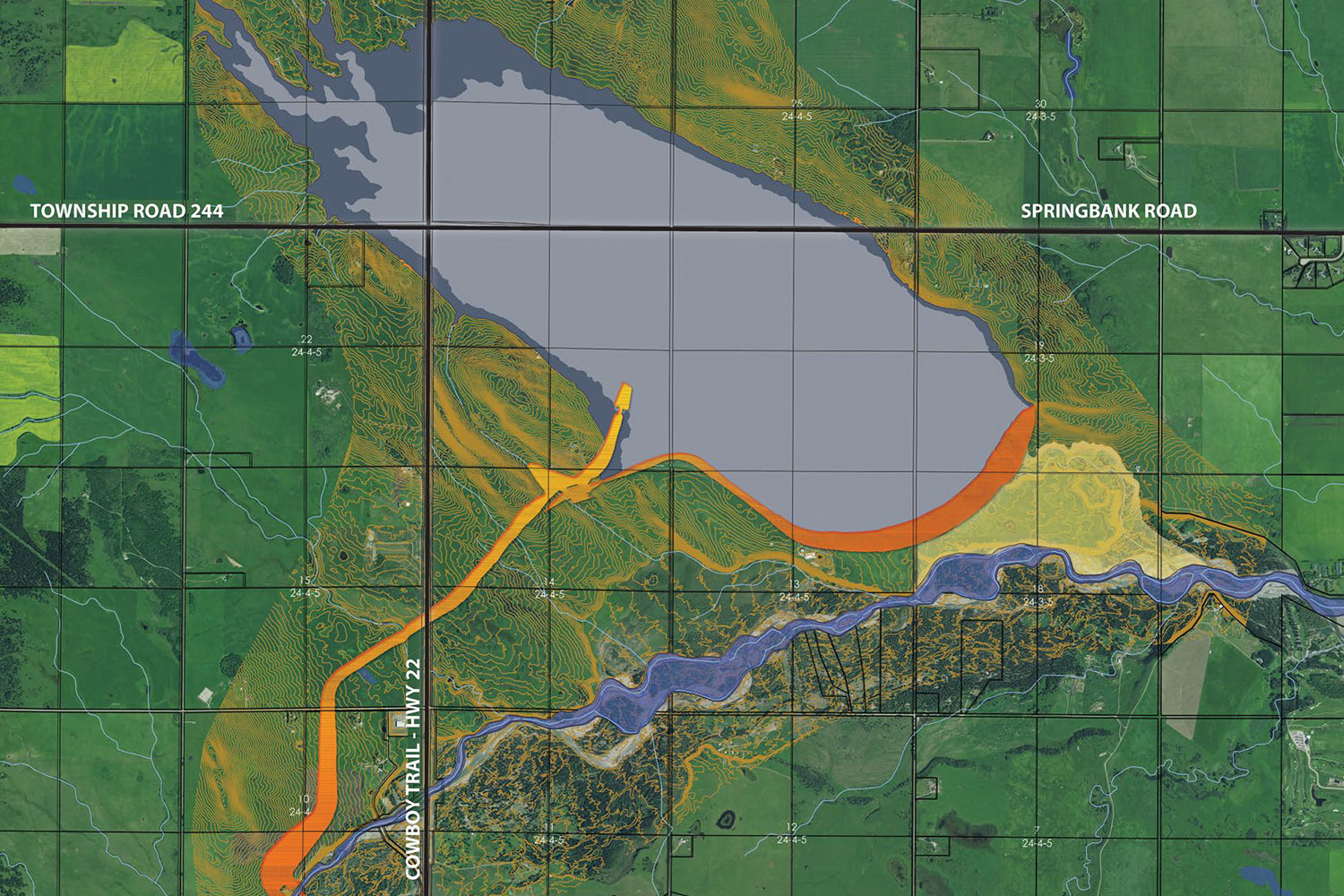
The Springbank Project dry reservoir, located about 15 kilometres west of Calgary, is designed store water temporarily during a flood. A diversion channel carries water from the Elbow River to the off-stream reservoir.
Courtesy Government of Alberta
Nov. 08, 2017 | Geoff Geddes
Crisis averted?
Flood mitigation efforts continue in the wake of 2013 disaster, but much still needs to be doneApart from the cool uniforms, boy scouts are known for their motto: be prepared. In the wake of the 2013 flood, Calgary and the province are taking a page from the Boy Scout handbook and hoping to write a happy ending for homeowners.
"In preparing for future risks, we recognize that flooding is a complicated problem," said Frank Frigo, senior planning engineer with water resources for the City of Calgary and the City's leader of watershed analysis.
"Geographically, it's much bigger than just Calgary, so we need local and regional solutions, and both structural and non-structural tools."
For Frigo, that means upstream dams, local infrastructure and policy must all fit together, complemented by education programs to inform people of the risks and help them limit their losses.
"Our studies have concluded that for Calgary, the backbone of flood resilience is structural mitigation," he said.
Two critical projects in that regard are the Springbank Off-Stream Reservoir – a provincial project – and the Glenmore Dam infrastructure upgrades led by the City of Calgary.
The Springbank Project is a dry reservoir about 15 kilometres west of Calgary that will store water temporarily during a flood. A diversion channel carries water from the Elbow River to the off-stream reservoir, which would have a storage capacity of 70.2 million cubic metres or about 28,000 Olympic-sized swimming pools. When peak waters have passed, an outlet structure safely releases the water back to the Elbow River in a controlled manner.
For the Glenmore Dam, "we are retrofitting the reservoir with a set of gates that will allow us to better manage both low and high flows. Together, Springbank and Glenmore can then handle a flood similar to 2013 with nominal damage," said Frigo.
The work on the Glenmore Dam will be complete in 2020.
In addition to these two high-profile projects, other work has been completed or is currently underway to shore up Calgary's flood defences.
"Geographically, it's much bigger than just Calgary, so we need local and regional solutions, and both structural and non-structural tools." - Frank Frigo, senior planning engineer with water resources for the City of Calgary
"Last year, a Bow River working group, including all water stakeholders along the river, evaluated options for new water storage, new reservoirs and other opportunities to address both floods and droughts," said Frigo. "They took a total water management approach and made a series of recommendations."
As well, community resilience programs have secured $150 million over the next 10 years to enhance local infrastructure, such as flood walls and drainage systems.
While there's still much to be done, many observers feel the city and province are moving in the right direction.
"These things take time," said Tony Morris, co-president of the Calgary River Communities Action Group. "River systems are very complex. If you do something in one place it will have implications downstream, so you need to understand how it all works together and the best strategies to employ."
The important thing in Morris's view is that governments have invested considerable time and money to enhance flood protection on several fronts, and continue to do so.
While that doesn't help those affected by the 2013 flood, it's critical for anyone that might have to endure "the next big one."
"People living and working in Calgary need a safe, secure environment and reassurance that risks to their home and/or business are low," said Charlie Lund of the Hillhurst Sunnyside Community Association (HSCA). Lund chairs the HSCA emergency preparation and response committee's infrastructure group that focuses on flood mitigation.
As a 12-year resident of Sunnyside, Lund thought there were measures in place to protect him, despite living in the river valley. However, the 2013 flood washed those notions away.
"My basement was ruined and we may have had sanitary sewer back-up," he said. "It was a huge upheaval and very distressing."
Even so, experts say 2013 could have been worse and should serve as an incentive for increased preparation going forward.
For those living in the higher-risk areas or considering it, Frigo said knowledge is critical.
"Go to our flooding information portal and view plans for mitigation and timelines," he said. "Before you buy a residence or improve your property, call 311 and learn about inherent risks in your community so you understand it all before making a move."
Meanwhile, Morris emphasized the need for proactive thinking when it comes to flood preparedness and mitigation going forward.
"What happened four years ago will happen again, and it will be worse," said Morris. "We're closer than we've ever been to addressing and managing the risk, but we can't forget how we got here."
Tagged: Calgary Real Estate News | Feature




